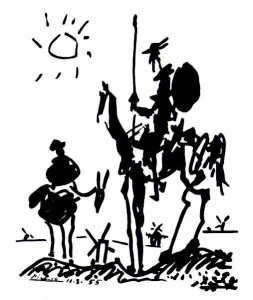Favourite writer: Miguel de Cervantes
Favourite writer: Miguel de Cervantes
Favourite writer: Miguel de Cervantes
-
Hannah
-
Hannah
 Too much sanity may be madness and the maddest of all, to see life as it is and not as it should be. –Miguel de Cervantes
Too much sanity may be madness and the maddest of all, to see life as it is and not as it should be. –Miguel de Cervantes
I was in my teens when I first began reading classic world literature, and when it came to Spanish literature, top of the list was Don Quixote by Cervantes. I recall very much enjoying the book back in those days, but then, recently, I rediscovered it while writing my forthcoming novel. Indiscretion is set in Spain, and so – as I always do when writing a new novel – I immersed myself in Spanish culture, past and present, to get into the mood for writing. I thoroughly enjoyed re-reading Don Quixote, and I thought today I would share with you something of that seminal work, and the man who wrote it.
A life of experience
Cervantes was born Miguel de Cervantes Saavedra in a town outside Madrid in 1547, son of a philandering barber-surgeon and a once-noblewoman who was sold into matrimony. As a young man, he worked as a chamber assistant of a cardinal in Rome and then in the Spanish navy. He was a brave soldier and was shot three times in battle, twice in the chest and once in the left arm, which was rendered useless (he later said he ‘had lost the movement of the left hand for the glory of the right’, for he wrote right-handed). Captured by Algerian corsairs, he spent five years as a slave and struggling to escape before being released when his parents paid his ransom, whereupon he returned to Madrid and worked as a purchasing agent for the Spanish Armada, and later as a tax collector, before landing in prison for inaccurate accounting. He died in 1616, and was buried in an unmarked grave at a convent – an initiative has now been launched to trace his remains and give them a more honourable memorial.
Don Quixote
Clearly, Cervantes had lived a life full of varied, colourful and sometimes painful experiences – perfect fodder for a writer’s imagination. He published his first novel, La Galatea, a romance, in 1585, and wrote plays that were produced for Madrid’s theatres. But it wasn’t until he published the first part of Don Quixotein 1605 that he saw any acclaim for his work. He released the second part the year before his death.
Don Quixoteis about an old man who is so taken with stories of brave knights of yesteryear that he sets out in search of adventure. So convinced does he become by his own fantasies that he manages to persuade a peasant, Sancho Panza, to be his squire. What ensues is a riot of adventures blending reality with fantasy until, finally, Don Quixote falls back down to earth with a bump.
Literature professors regard Cervantes’ magnum opus as the first modern European novel and one of the best works of fiction in history. Fyodor Dostoyevsky, one of my favourite authors, called it ‘the ultimate and most sublime work of human thinking’. What made the book so groundbreaking and wildly popular was a new style that Cervantes pioneered,favouring clear language and natural dialogue over literary pretension. It’s a very funny book, satirising the romance of chivalry, but among the wit is a great deal of wisdom. Axioms such of these are from Don Quixote:
- The proof of the pudding is in the eating.
- Who walks much and reads much, knows much and sees much.
- He who plays with cats must expect to get scratched.
The Cervantes legacy
Cervantes’ work created waves of change in the Spanish language, so much so it’s been termed since ‘the language of Cervantes’. But during his lifetime Don Quixote was not widely known, and he was certainly not rich from his writing. His work was all but forgotten until, in the 18th century, English and German scholars began re-examining Don Quixote. Not until the 20th century, though, did Cervantes’ reputation build to the point that his book had been translated into all major languages and published in 700 editions, and was the commonly known work we celebrate today.
If you haven’t read the book, I highly recommend it for your ‘to read’ list. I will leave you with the famous depiction of Don Quixote and Sancho Panchez by Pablo Picasso, 1955. Such humour!
